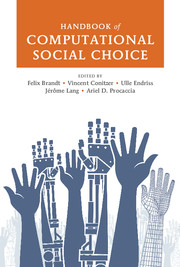Book contents
- Frontmatter
- Contents
- Foreword
- Contributors
- 1 Introduction to Computational Social Choice
- Part I Voting
- 2 Introduction to the Theory of Voting
- 3 Tournament Solutions
- 4 Weighted Tournament Solutions
- 5 Dodgson's Rule and Young's Rule
- 6 Barriers to Manipulation in Voting
- 7 Control and Bribery in Voting
- 8 Rationalizations of Voting Rules
- 9 Voting in Combinatorial Domains
- 10 Incomplete Information and Communication in Voting
- Part II Fair Allocation
- Part III Coalition Formation
- Part IV Additional Topics
- References
- Index
8 - Rationalizations of Voting Rules
from Part I - Voting
Published online by Cambridge University Press: 05 May 2016
- Frontmatter
- Contents
- Foreword
- Contributors
- 1 Introduction to Computational Social Choice
- Part I Voting
- 2 Introduction to the Theory of Voting
- 3 Tournament Solutions
- 4 Weighted Tournament Solutions
- 5 Dodgson's Rule and Young's Rule
- 6 Barriers to Manipulation in Voting
- 7 Control and Bribery in Voting
- 8 Rationalizations of Voting Rules
- 9 Voting in Combinatorial Domains
- 10 Incomplete Information and Communication in Voting
- Part II Fair Allocation
- Part III Coalition Formation
- Part IV Additional Topics
- References
- Index
Summary
Introduction
From antiquity to these days, voting has been an important tool for making collective decisions that accommodate the preferences of all participants. Historically, a remarkably diverse set of voting rules have been used (see, e.g., Brams and Fishburn, 2002), with several new voting rules proposed in the last three decades (Tideman, 1987; Schulze, 2003; Balinski and Laraki, 2010). Thus, when decision-makers need to select a voting rule, they have plenty of choice: should they aggregate their opinions using something as basic as Plurality voting or something as sophisticated as Ranked Pairs? Or should they perhaps design a new voting rule to capture the specific features of their setting?
Perhaps the best known way to answer this question is to use the axiomatic approach, that is, identify desirable properties of a voting rule and then choose (or construct) a rule that has all of these properties. This line of work was initiated by Arrow(1951) and led to a great number of impossibility theorems, as it turned out that some desirable properties of voting systems are incompatible. By relaxing these properties, researchers obtained axiomatic characterizations of a number of classical voting rules, such as Majority (May, 1952), Borda (Young, 1975), and Kemeny (Young and Levenglick, 1978); see the survey by Chebotarev and Shamis (1998) as well as Chapter 2.
However, early applications of voting suggest a different perspective on this question. It is fair to say that in the Middle Ages voting was most often used by religious organizations (Uckelman and Uckelman, 2010). The predominant view in ecclesiastical elections was that God's cause needed the most consecrated talent that could be found for leadership in the church. Moreover, it was believed that God knew who the best candidate was, so the purpose of elections was to reveal God's will. It is therefore not surprising that when the Marquis de Condorcet (1785) undertook the first attempt at systematization of voting rules, he was influenced by the philosophy of church elections. His view was that the aim of voting is to determine the “best” decision for the society when voters are prone to making mistakes.
Information
- Type
- Chapter
- Information
- Handbook of Computational Social Choice , pp. 169 - 196Publisher: Cambridge University PressPrint publication year: 2016
Accessibility standard: Unknown
Why this information is here
This section outlines the accessibility features of this content - including support for screen readers, full keyboard navigation and high-contrast display options. This may not be relevant for you.Accessibility Information
- 6
- Cited by
